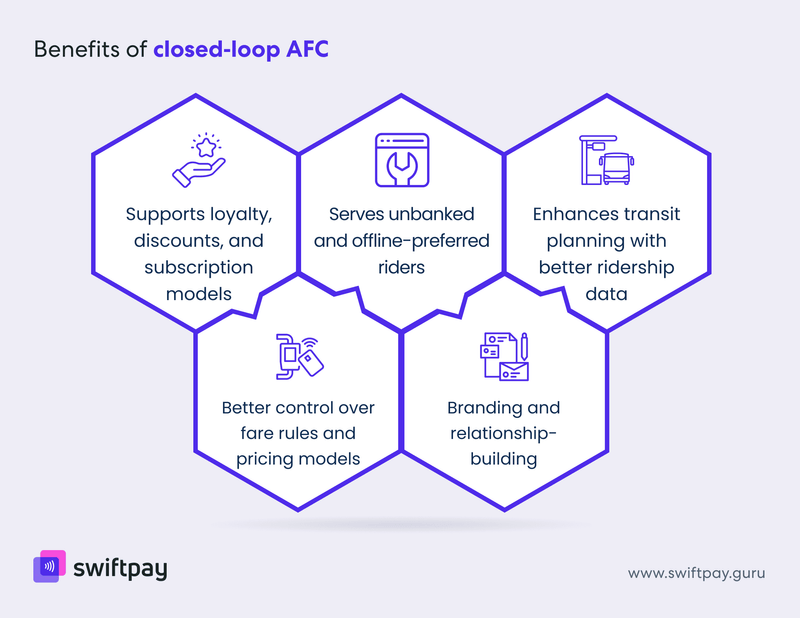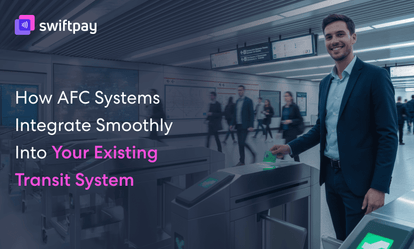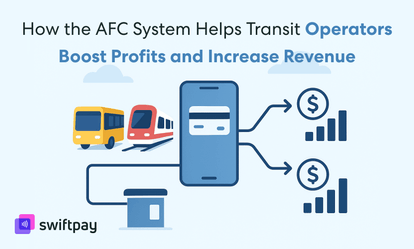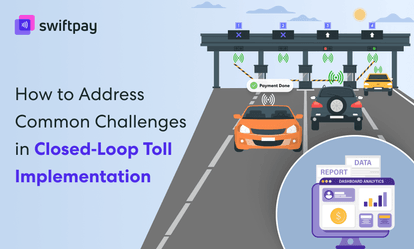Public transport only works when it works for everyone.
That means quick boarding, fair pricing, fewer queues, and systems that don’t confuse commuters or burden operators like you.
And that’s where auto fare collection comes in. It's so much more than ditching paper tickets; it’s about building smarter infrastructure that supports how people actually move through cities.
But here’s the catch: primarily, there are two ways to automate fare collection.
One is open-loop, and the other is closed-loop. Each has strengths, and each solves a different part of the puzzle.
This blog will help you understand what each of these means, how they are different from each other, and how closed loop auto fare collection system complement open-loop system.
Transit operators like you who are looking to modernize your fare collection without losing control, this one's for you.
What is Auto Fare Collection?
Auto fare collection (AFC) refers to digital systems that handle fare payments across public transit networks.
These systems replace manual ticketing, cash transactions, and paper-based passes with electronic payment methods such as cards, e-wallets, and apps. This helps streamline fare collection.
It’s a well-known system and it’s been used in many cities across the world.
Tap to pay is one of the most common ways to pay for public transit in many cities.
And automatic fare collection is done with two types of payments: Open-loop payments and closed-loop payments.
What is an open-loop auto fare collection?
Open-loop AFC relies on payment instruments issued by banks or third parties, i.e., Visa cards, Apple Pay, Google Pay, and other contactless methods.
Riders use what’s already in their pocket to pay for their fare. This system is popular in large metro areas like London and Singapore, where transit authorities like yours want to make life easier for tourists and infrequent riders.
It’s all about interoperability. Open-loop payment systems can work across different services and agencies, which helps deliver a smoother, more unified experience, especially for first-timers or occasional users.
What is a closed-loop auto fare collection?
Closed-loop automated fare collection runs on transit-issued payment tools, smart cards, or closed loop e-wallets, that work exclusively within your system.
From metro cards to student bus passes to shuttle ride apps, the idea is simple: riders load funds into a system you manage, and payments happen within your network.
These systems are ideal for daily commuters, students, staff, senior citizens—basically, people who use your service regularly and whose experiences you want to control, improve, and personalize.
Difference Between Open-Loop and Closed-Loop Auto Fare Collection
The table below shows differences between open-loop and closed-loop AFC systems across various aspects:
| Parameter | Open-Loop | Closed-Loop |
|---|---|---|
| Payment Method | Bank cards, mobile wallets | Smart transit cards, e-wallets, or apps |
| User Onboarding | No sign-up required | Sign-up or card issuance required |
| Best For | Tourists, casual users | Daily commuters, pass holders, students |
| Control Over Fare Rules | Limited (set by banks/processors) | Full control by the transit operator |
| Data Ownership | Shared with payment providers | Owned by the operator/transit authority |
| Offline Access | Limited fallback only | Fully functional offline (with preloaded value) |
| Inclusivity | Banked users only | Suitable for unbanked users |
| Custom Incentives | Hard to implement | Easy to configure and run |
Why open-loop is the default system—and why it makes sense
Open-loop payments have become the go-to standard for cities modernizing their fare systems. And in many ways, it’s the logical choice. There are multiple reasons behind that:
Convenience for first-time or occasional riders
Commuters don’t need to learn a new system or download a specific app. They just use their existing bank card or smartphone and pay their fares.
For tourism-heavy transit systems or large networks with many one-time users, that’s a win.
Seamless interoperability
Open-loop works well in systems with multiple operators or regional authorities. It supports a unified mobility experience, especially when integrated into MaaS (Mobility as a Service) platforms.
Reduced operational overhead
Since fare processing runs through the banking (or third-party) systems, you don’t need to manage card issuance, recharges, or refunds. This means less complexity for your operations team.
Scalable across regions and services
Whether your system expands into neighboring cities or integrates with parking, rideshare, or toll networks, open-loop provides a path to wide-scale adoption.
It’s simple: people will keep on using their existing bank cards or mobile apps for payment.
What’s the need for closed-loop AFC?
Open-loop payments are familiar, and they simplify fare collection, but they don't solve every challenge.
If you only think in terms of “accept all bank cards,” you miss the opportunity to:
- Serve more specific needs
- Offer better experiences
- Build long-term value
Closed loop transit payment solutions help you overcome these challenges.
How closed-loop AFC complements open-loop payments
This isn’t a binary choice. Usually, open-loop and closed-loop automatic fare collection systems can work together. And they should. Because it gives freedom and flexibility to your customers.
Closed-loop transit payment systems add features and flexibility you simply don’t get from bank-issued payments. Let’s explore them one by one:

Supports loyalty, discounts, and subscription models
You can create and offer monthly pass programs, offer discounted rides to students or seniors, and tailor incentives for repeat commuters. Open-loop systems don’t give you this level of control.
Serves unbanked and offline-preferred riders
You should consider the possibility that not everyone has a debit card. And not every location has reliable internet.
Closed-loop AFC systems offer smart prepaid cards and offline-compatible virtual cards that work for everyone, regardless of connectivity or financial access.
Enhances transit planning with better ridership data
When you have full control of the payment network, you also control the data.
That means better insights into:
- Peak hours
- Trip frequencies
- Rider behavior, and much more.
This allows you to make smarter operational decisions, optimize routes, and adjust pricing models in real time.
Better control over fare rules and pricing models
Want to cap daily spending, implement distance-based pricing, or vary fares by time of day? A closed-loop automated fare collection system allows you to implement custom fare prices that reflect your system’s needs.
Branding and relationship-building
A closed-loop prepaid card or a custom transit e-wallet app isn’t just a fare payment tool; it’s a brand touchpoint as well.
When your card (or e-wallet) lives in someone’s pocket, they’re not just using your service. They’re using your system too.
That subtle distinction builds familiarity and long-term loyalty.
Read more: Why Closed-Loop Payment Solutions Are Key to Effective Automatic Fare Collection
Final Words
In summary, an open-loop offers speed and scale. It removes barriers, simplifies payments, and appeals to one-time riders or occasional riders.
But when it comes to serving regulars or convincing people to use your service regularly, you need to offer personalization, flexibility, and control. That’s where a closed-loop auto fare collection system is helpful.
The thing is that you don’t necessarily have to choose between the two systems. You have already seen how closed-loop payments complement open-loop payments.
With a solution like SwiftPay, you gain the flexibility to run your own fare rules, support offline and unbanked users, and create experiences that feel tailored, not transactional.
It allows you to control the payment ecosystem, and that control unlocks new opportunities.
If you're looking to build something smarter, more inclusive, and more sustainable, a closed-loop transit payment solution might just be the lever you're missing.




